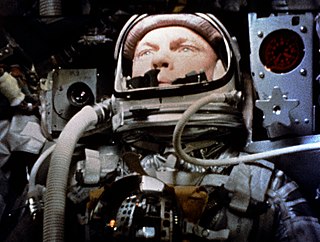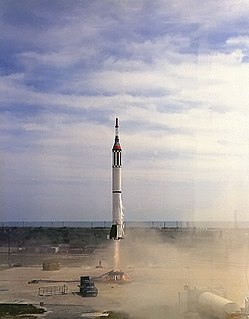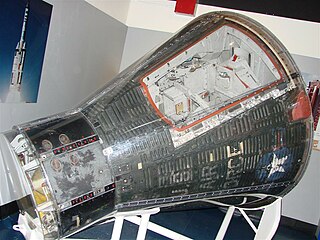
Project Mercury was the first human spaceflight program of the United States, running from 1958 through 1963. An early highlight of the Space Race, its goal was to put a man into Earth orbit and return him safely, ideally before the Soviet Union. Taken over from the US Air Force by the newly created civilian space agency NASA, it conducted 20 uncrewed developmental flights, and six successful flights by astronauts. The program, which took its name from Roman mythology, cost $2.38 billion. The astronauts were collectively known as the "Mercury Seven", and each spacecraft was given a name ending with a "7" by its pilot.

Mercury-Redstone 3, or Freedom 7, was the first United States human spaceflight, on May 5, 1961, piloted by astronaut Alan Shepard. It was the first crewed flight of Project Mercury. The project had the ultimate objective of putting an astronaut into orbit around the Earth and return him safely. Shepard's mission was a 15-minute suborbital flight with the primary objective of demonstrating his ability to withstand the high g-forces of launch and atmospheric re-entry.

Mercury-Redstone 4 was the second United States human spaceflight, on July 21, 1961. The suborbital Project Mercury flight was launched with a Mercury-Redstone Launch Vehicle, MRLV-8. The spacecraft, Mercury capsule #11, was nicknamed the Liberty Bell 7. It was piloted by astronaut Virgil "Gus" Grissom.

Mercury-Atlas 6 (MA-6) was the first American orbital spaceflight, which took place on February 20, 1962. Piloted by astronaut John Glenn and operated by NASA as part of Project Mercury, it was the fifth human spaceflight, preceded by Soviet orbital flights Vostok 1 and 2 and American sub-orbital flights Mercury-Redstone 3 and 4.

Mercury-Atlas 8 (MA-8) was the fifth United States crewed space mission, part of NASA's Mercury program. Astronaut Walter M. Schirra Jr., orbited the Earth six times in the Sigma 7 spacecraft on October 3, 1962, in a nine-hour flight focused mainly on technical evaluation rather than on scientific experimentation. This was the longest U.S. crewed orbital flight yet achieved in the Space Race, though well behind the several-day record set by the Soviet Vostok 3 earlier in the year. It confirmed the Mercury spacecraft's durability ahead of the one-day Mercury-Atlas 9 mission that followed in 1963.

Mercury-Atlas 9 was the final crewed space mission of the U.S. Mercury program, launched on May 15, 1963, from Launch Complex 14 at Cape Canaveral, Florida. The spacecraft, named Faith 7, completed 22 Earth orbits before splashing down in the Pacific Ocean, piloted by astronaut Gordon Cooper, then a United States Air Force major. The Atlas rocket was No. 130-D, and the Mercury spacecraft was No. 20. As of 2022, this mission marks the last time an American was launched alone to conduct an entirely solo orbital mission.

Mercury-Atlas 5 was an American spaceflight of the Mercury program. It was launched on November 29, 1961, with Enos, a chimpanzee, aboard. The craft orbited the Earth twice and splashed down about 200 miles (320 km) south of Bermuda, and Enos became the first primate from the United States and the third great ape to orbit the Earth.

Mercury-Atlas 10 (MA-10) was a cancelled early crewed space mission, which would have been the last flight in NASA's Mercury program. It was planned as a three-day extended mission, to launch in late 1963; the spacecraft, Freedom 7-II, would have been flown by Alan Shepard, a veteran of the suborbital Mercury-Redstone 3 mission in 1961. However, it was cancelled after the success of the one-day Mercury-Atlas 9 mission in May 1963, to allow NASA to focus its efforts on the more advanced two-man Gemini program.

Mercury-Atlas 1 (MA-1) was the first attempt to launch a Mercury capsule and occurred on July 29, 1960 at Cape Canaveral, Florida. The spacecraft was unmanned and carried no launch escape system. The Atlas rocket suffered a structural failure 58 seconds after launch at an altitude of approximately 30,000 feet (9.1 km) and 11,000 feet (3.4 km) down range. All telemetry signals suddenly ceased as the vehicle was passing through Max Q. Because the day was rainy and overcast, the booster was out of sight from 26 seconds after launch, and it was impossible to see what happened.

Mercury-Redstone 1 (MR-1) was the first Mercury-Redstone uncrewed flight test in Project Mercury and the first attempt to launch a Mercury spacecraft with the Mercury-Redstone Launch Vehicle. Intended to be an uncrewed sub-orbital spaceflight, it was launched on November 21, 1960 from Cape Canaveral Air Force Station, Florida. The launch failed in abnormal fashion: immediately after the Mercury-Redstone rocket started to move, it shut itself down and settled back on the pad, after which the capsule jettisoned its escape rocket and deployed its recovery parachutes. The failure has been referred to as the "four-inch flight", for the approximate distance traveled by the launch vehicle.

Mercury-Redstone 2 (MR-2) was the test flight of the Mercury-Redstone Launch Vehicle just prior to the first crewed American space mission in Project Mercury. Carrying a chimpanzee named Ham on a suborbital flight, Mercury spacecraft Number 5 was launched at 16:55 UTC on January 31, 1961 from LC-5 at Cape Canaveral, Florida. The capsule and Ham, the first great ape in space, landed safely in the Atlantic Ocean 16 minutes and 39 seconds after launch.

Mercury-Redstone BD was an uncrewed booster development flight in the U.S. Mercury program. It was launched on March 24, 1961 from Launch Complex 5 at Cape Canaveral, Florida. The mission used a boilerplate Mercury spacecraft and Redstone MRLV-5.

Mercury-Atlas 2 (MA-2) was an unmanned test flight of the Mercury program using the Atlas rocket. It launched on February 21, 1961 at 14:10 UTC, from Launch Complex 14 at Cape Canaveral, Florida.

Little Joe 5 was the November 8, 1960, unmanned atmospheric test flight of the Mercury spacecraft, conducted as part of the U.S. Mercury program. The objective was to test a production Mercury capsule (#3) and the launch escape system during an ascent abort at maximum dynamic pressure. The mission was launched from Wallops Island, Virginia. Sixteen seconds after liftoff, the escape rocket and the tower jettison rocket both fired prematurely. Furthermore, the booster, capsule, and escape tower failed to separate as intended. The entire stack was destroyed on impact with the Atlantic Ocean. The Little Joe 5 flew to an apogee of 10.1 miles (16.2 km) and a range of 13 miles (20.9 km). Some capsule and booster debris was recovered from the ocean floor for post flight analysis.

Little Joe 5A was an unmanned launch escape system test of the Mercury spacecraft, conducted as part of the U.S. Mercury program. It was an attempted re-test of the failed Little Joe 5 flight. The mission used production Mercury spacecraft #14 atop a Little Joe booster rocket. The mission was launched March 18, 1961, from Wallops Island, Virginia. The LJ-5 failure sequence was repeated when capsule escape rocket again ignited prematurely with the capsule remaining attached to the booster. In this flight however, a ground command was sent to separate the capsule from the booster and escape tower. This allowed the main and reserve parachutes to deploy and the capsule was recovered with only minor damage. It would be used again on the subsequent Little Joe 5B mission, in a third attempt to achieve mission objectives. The Little Joe 5A flew to an apogee of 7.7 miles (12 km) and a range of 18 miles (29 km). The mission lasted 5 minutes 25 seconds. Maximum speed was 1,783 miles per hour (2,869 km/h) and acceleration was 8 G (78 m/s²).

Little Joe was a solid-fueled booster rocket used by NASA for eight launches from 1959-1960 from Wallops Island, Virginia to test the launch escape system and heat shield for Project Mercury capsules, as well as the name given to the test program using the booster. The first rocket designed solely for crewed spacecraft qualifications, Little Joe was also one of the pioneer operational launch vehicles using the rocket cluster principle.

A space capsule is an often-crewed spacecraft that uses a blunt-body reentry capsule to reenter the Earth's atmosphere without wings. Capsules are distinguished from other satellites primarily by the ability to survive reentry and return a payload to the Earth's surface from orbit. Capsule-based crewed spacecraft such as Soyuz or Orion are often supported by a service or adapter module, and sometimes augmented with an extra module for extended space operations. Capsules make up the majority of crewed spacecraft designs, although one crewed spaceplane, the Space Shuttle, has flown in orbit.

A boilerplate spacecraft, also known as a mass simulator, is a nonfunctional craft or payload that is used to test various configurations and basic size, load, and handling characteristics of rocket launch vehicles. It is far less expensive to build multiple, full-scale, non-functional boilerplate spacecraft than it is to develop the full system. In this way, boilerplate spacecraft allow components and aspects of cutting-edge aerospace projects to be tested while detailed contracts for the final project are being negotiated. These tests may be used to develop procedures for mating a spacecraft to its launch vehicle, emergency access and egress, maintenance support activities, and various transportation processes.
The Mercury-Redstone Launch Vehicle, designed for NASA's Project Mercury, was the first American crewed space booster. It was used for six sub-orbital Mercury flights from 1960–1961; culminating with the launch of the first, and 11 weeks later, the second American in space. The four subsequent Mercury human spaceflights used the more powerful Atlas booster to enter low Earth orbit.

Gemini SC-2 was the second NASA Project Gemini full-up reentry capsule built. This McDonnell Gemini capsule was the first space capsule to be reused, flying twice in suborbital flights. SC-2 flew on Gemini 2 and OPS 0855 flights. The capsule is currently on display at the Air Force Space and Missile Museum at Cape Canaveral Air Force Station.





















